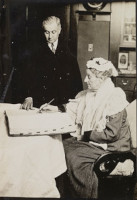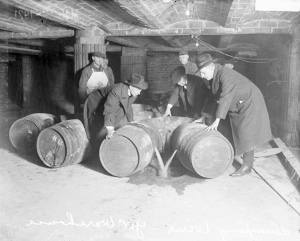Exhibits > Voting for Women > Suffrage and Prohibition
Suffrage and Prohibition
The late teens and early 1920s ushered in great change to the U.S. Constitution. The 19th amendment was not the only one that passed with lasting ramifications. Just one year earlier, in 1919, another amendment was ratified which would take effect in 1920. The 18th amendment, commonly known as Prohibition, stated:
“… the manufacture, sale, or transportation of intoxicating liquors within, the importation thereof into, or the exportation thereof from the United States and all territory subject to the jurisdiction thereof for beverage purposes is hereby prohibited.”

Abigail Scott Duniway (1834–1915) registers as first woman voter in Portland, February 14, 1913. Photograph. NWP Records, Manuscript Division, Library of Congress (048.00.00)
At first glance the connection between Prohibition and women’s suffrage might not be readily apparent, but the two are intricately and inextricably linked in history. Women led the movement to pass Prohibition. Susan B. Anthony and Elizabeth Cady Stanton, both well-known suffragists, advocated for prohibition. In Oregon, the two movements maintained an often contentious relationship. Prominent Suffragist Abigail Scott Duniway supported temperance, but stood against prohibition believing that it could prevent women from achieving the vote. In 1912 Duniway registered as the first woman to vote in Oregon; however, the fight over prohibition in Oregon was not finished.
In Multnomah County, votes on the issue of prohibition took place in both 1910 and 1913. In 1910, four precincts voted against prohibition. By 1912, the Prohibition Party had eight contestants for State representation. Although the total number of votes those candidates garnered was smaller than those of either the Socialist or Progressive parties, support for prohibition was growing. In the 1913 vote, the balance had shifted: five precincts and Gresham voted in favor of prohibition. By 1916, Oregon state law banned the sale of liquor. State and federal repeal of Prohibition did not take place until 1933, with Oregon again leading the way and repealing the state constitutional amendment a few months prior to ratifying the 21st amendment to the US Constitution.
Multnomah County Record of Elections, Prohibition Measure, Local Details, General Election, 8 Nov 1910, Records of the Elections Division, Multnomah County Archives.
Multnomah County Record of Elections, Prohibition Party Candidates, General Election, 5 Nov 1912, Records of the Elections Division, Multnomah County Archives.
Multnomah County Record of Elections, Prohibition Measure, Local Details, Special Election, 4 Nov 1913, Records of the Elections Division, Multnomah County Archives.
<<Previous: New Voices in the Elections Process | Next: Opposition>>


